Pour Paintings

oil on panel 12″x12″
“Viscosity” Pour Painting
My technique is based on the “simultaneous color printing” method devised by Stanley Hayter (1901-1988) in his etchings and lithographs. Hayter found that oil colors of different consistency not only did not blend, but they repelled each other. I pour oil colors of different viscosities onto a flat panel, and by tilting and manipulating the flow, I can control and create the image.

















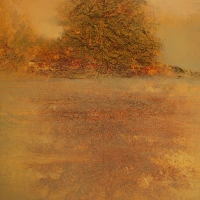
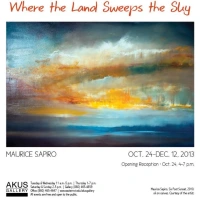
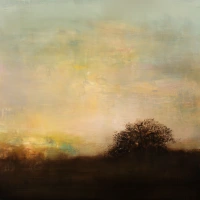
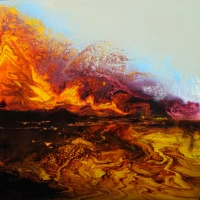

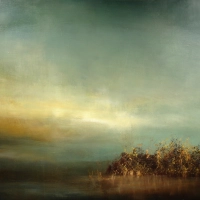
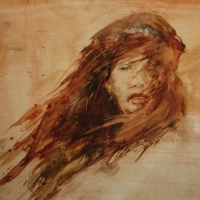
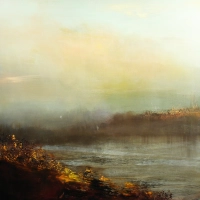
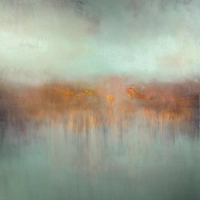
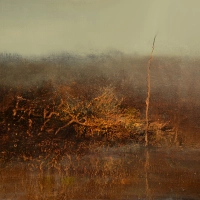

Pingback: Viscosity Pour Painting « Maurice Sapiro Studio Gallery
Wow, I feel the power in your work.
LikeLike
Breathtaking!
I will have to try my hand at this as soon as possible!
Do you think water soluble oils would work?
LikeLike
I’m not sure. Try it, this may be your big breakthrough. If it doesn’t work, you can always blame me.
LikeLike
I shall find out!
& I would only say that I was taught from a master and didn’t follow his advice precisely. 😛
LikeLike
especially like these!
LikeLike
Maurice,
The colours and patterns are amazing. Viscosity I is my favourite.
Chris
LikeLike
Excellent pieces.
LikeLike
love these!
LikeLike
Puts a whole new twist on ‘go with the flow’. Beautiful.
LikeLike
Beaytiful!
LikeLike
Beautiful and intriguing! I’d love to see a film of you making these. How do you thin the paints?
LikeLike
The secret in thining is to have the colors mixed in varied dilutions. I use mineral spirits mixed with Liquin (Winsor Newton product) in various proportions as a basic thinner, stirred into the pigment until it is pourable. As long as the proportion of dilution in the different colors remains unequal, the paint will repel adjacent colors. I keep a spray bottle of mineral spirits handy, to break down the repelling action, where needed, to allow the colors to blend. I found that the mixture amounts are not critical, as long as each color has a diferent viscosity. It’s a lot easier to do than explain. Hope this gets you started. Thanks for looking.
LikeLike
Maurice, would you mind please telling us what surfaces you use for these pour paintings? I suppose something with a smoother surface than a canvas?
Thank you in advance!
LikeLike
Elena, I use pressboard, (sometimes referred to as Masonite), The primer is gesso, applied with a smooth nap roller, and sanded before the pour is attempted. I did a large pour painting, “Yellow Cloud” 38″x32″ which is on canvas. Here I troweled on thick gesso to smooth the surface. You are right—a smooth surface is needed.
LikeLike
Thanks for your generous reply!
LikeLike
Beautiful work, it reminds me of glass prints I used to do in school, love these 🙂
LikeLike
Amazing. Its a very interesting technique.
LikeLike
Your work is really beautiful!
LikeLike
Thank you!
LikeLike
Truly Inspiring. The birth of galaxies.
LikeLike
Several of these I was sure were photos of lava when I first looked. Lately I’ve looked into similar pour techniques with watercolor but this is the first I’ve heard of it being done with oil paint. I’ll try this. 🙂
LikeLike
aargh I don’t know how to message you as me instead of lovers orchard, which is an entirely different blog site! But wanted to say I really enjoyed your paintings, your landscapes are really my kind of thing!! 🙂 (carolyn morris)
LikeLike
Your work is so colorful & Beautiful! Your sky scenes are so realistic ! ! *Cynthia
LikeLike
Wonderful and inspiring.
LikeLike
Energetic and inspiring.
LikeLike
Thank You for liking my Still Life !! 🙂 *Cynthia
LikeLike
These are beautiful! I love the energy behind them! You have some fantastic art.
LikeLike
These are so cool that I had to pin them. I enjoyed viewing your landscapes as well, definitely got the Turner thing going on. Thanks for following my blog. I’ll be following your work too.
LikeLike
Some of these look like Australian desert landscapes, Maurice. Very strong and bold. Thanks for following my blog, I’ll be sure and recommend yours!
LikeLike
Really beautiful and your work is “Turner like” lovely sense of color and airy space. I’ve done this with Acrylics but never oil! Must try soon. I love your landscapes too so peaceful and iridescent.
LikeLike
These are cool looking!
LikeLike
Stunning work Maurice! Very nice technique and most intriguing for the viewer. Well done!
LikeLike
Karen, thank you for your thoughtful comment-much appreciated!
LikeLike
I see everything from raging seas, to satellite photos, to leaves,to gathering storms, to hell fire and brimstone – some wonderful and beautiful effects.
LikeLike
I’ve been pouring all morning—tune in tomorrow, some more surprises.
LikeLike
See you then 🙂
LikeLike
like gold or fire – surprising technique!
LikeLike
Thanks for viewing and commenting.
LikeLike
WOW! I fall in love with these beautiful paintings… colours hit me…Thank you, Blessing and Happiness, love, nia
LikeLike
Nia, Thank you–my blessings in return.
Maurice
LikeLike
You are an all around artist.. I see. Marvelous!
LikeLike
gorgeous colors. quite stunning compositions, they must be mesmerizing in person.
LikeLike
And as they are happening, it’s magic!
LikeLike
These are amazing!
LikeLike
Thank you. They’re to be included in my retrospective at Eastern CT State U.
LikeLike
Love looking at these. Interesting how abstract swirls can evoke the sky, water, space, a landscape, so many things.
LikeLike
I could find life in your paintings
LikeLike
Me too!
LikeLike
I really love these paintings and the color in them…
LikeLike
Thank you Erica!
LikeLike
You’re welcome, Maurice!
LikeLike
I just looked at your work under portfolio but could not find a way to respond or comment, so, I’m doing it here. Everything I saw was beautiful. Full of energy and motion. Wonderful. Enjoyed it so very much. Thank you.
LikeLike
These are so beautiful , I love all the energy of your work.
LikeLike
it’s breathtaking.
LikeLike
I’m in total awe, not just with how you created these, I’m…speechless. They are so beautiful!
LikeLike
More spectacular works! Mr McArthur (above) had a similar reaction to mine: much here looks celestial and interstellar. I also see a lot of lava flows! Gorgeous stuff, no matter what I see in it.
LikeLike
Great technique! I learned about viscosity printing when I started hanging out with printmakers, and have some friends that do watercolour pour paintings, but have never seen anyone do this with oils Wonderful results — someone further up in the comments said “Turner-like” and that’s exactly what I have thought about your work. Lovely.
LikeLike
I can really learn from you, thank you
LikeLike
Gorgeous work, dynamic and vibrant! You mention adding liquin and mineral spirits to get the oil paint “pourable.” Do you use tube paints? Because it seems as though the mixing of large amounts of color would be tedious. Do you mix large batches in containers? Thanks for your advice on this.
LikeLike
Thanks for looking and liking. Yes, I use tube paints, small batches, in 8 ounce bottles, It is tedious. Sometimes the mixing takes more time than the pairing.
LikeLike
Thanks so much for the prompt reply! I love it when artists are also good at “taking care of the business” of art. Do you use glass or metal 8 oz bottles? I’m wondering if plastic will react with the mineral spirits/liquin/oil paint mix? Thanks for having patience with these questions.
LikeLike
It’s best to use glass. I’m using old sauce jars with metal lids. After I sent the last answer, I checked and found t’m using 16 ounce bottles. The dilution is important—lumps disrupt the process. Good luck!
LikeLiked by 1 person
Thank you for such a generous amount of information. I’m excited to play with this. I’ve always worked with realism, but it’s good to get outside our comfort boxes and explore…you are an inspiration!
LikeLike
I am completely in love with your work. You inspire my spirit!
LikeLike
All of these are just fabulous.. In awe… thank you … Sue
LikeLike
Beautiful Art Work. Much appreciated!!1
LikeLike
Breathtaking. Wonderful stuff.
LikeLike
Your work is truly inspiring and these pour paintings are simply stunning. I adore texture and when I saw these I wondered if you used acrylic mediums to get that surface texture. I love oils but suffer from MCS thus haven’t yet been brave enough tho have bought what i think i can use given my limits, namely no odor turp, liquin, tho really, I don’t know what I’m talking about … YET! 😉
I’m happy to have found your site and plan to read everything here. Many Blessings…
LikeLike
Thanks for commenting, and thanks for your kind words. I did not use any acrylic mediums to obtain the texture. It’s all the result of the various oil mixtures. Somewhere in my blog I mention my allergies that caused headaches, finally narrowed it down to the odor of Linseed oil, and turps. Switched to Liquin and odorless mineral spirits, with success .My blessings in return. Maurice
LikeLiked by 1 person
You are very nice to share all of your information. It must have taken you a lot of practice to tell us what you are doing now. I really think it is great that you share!! What you are doing is beautiful. You are beautiful on the inside also.
LikeLike
Thank you Dorothy. You sure know how to make an old man smile. I really appreciate your kind words !!
LikeLike
I came across your page by accident, because I was looking at acrylic pouring sites. Your work is lovely! There is just a nice richness of colors with oils, that acrylics can’t quite compete with 🙂. Maybe some day I’ll get brave enough to try your technique!
LikeLike
Thanks for your kind words. Yes, I agree, only oils can produce this effect. Go ahead, get brave, it’s worth the effort . And good luck !!!
LikeLike
Love your work. I have done similar applications in watercolor and acrylics with lots of alcohol and floetrol and sometimes a little salt. What ever it takes to get the effect.
LikeLike
Thanks Lyn, sometimes I pour my heart out ! Whatever it takes !
LikeLike
I am wanting to fluid paint my metal counter tops at work with oil paint. Do I need to add turpentine to it? Or is there something else to make it thinner?
LikeLike
Metal tops present no problem. I dilute with Oderless Mineral Spirits, and Winsor & Newton Liquin.
LikeLike
Thank you so much Maurice for your inspirational beautiful breathtaking creations. I came across this when looking for Oil pour techniques as I use oils not acrylics.
Firstly thank you for your information about odourless mineral spirits and liquin. I have been struggling to find something to replace the overbearing odour of turpentine and white spirits etc which is what they taught us with in art class.
I was hoping you may have the time to answer a question of mine. When you say you mix different viscosities, do you mean different viscosities of the mineral spirit and liquin (before added to the paint?), or do you mean exactly the same viscosity of spirit and liquin but in varying amounts in the pigment, therefore resulting in a different in each pigment having a different viscosity?
I appreciate in advance your reply.
Much appreciation and thanks and also Wow! For your absolutely stunning artworks, such an inspiration ❤ ❤
LikeLike
Thank you ! I vary the proportions of of Liquin and mineral spirits. I just discovered that odorless mineral spirits are no longer available, in our attempt at a greener world. Not sure what I will do \in the future.
LikeLike
Thank you so much Maurice for your reply, very much appreciated. Very happy I have a formula to attempt this technique 😃.
Thank you for telling me odourless mineral spirit is no longer available. I shall see if I can find an alternative! 🙂 Maya
LikeLiked by 1 person
How have these paintings held up over time? I’ve read a lot of people saying that adding too much medium/solvent can cause oil paintings to become unbound causing them to flake or chalk off the canvas. It’s prevented me from being more experimental with oil paint in the past. However, these paintings are beautiful. I tend to work in more fine, technical detail, but am finding myself drawn to more expressionist techniques. I’d love to play around with a technique like this and would appreciate any advice! Thank you for sharing your breathtaking work!
LikeLike
Thanks for your kind comments. I have not experienced any problems, even with the paintings that are 25 years old. No cracking, or pealing. II pour( for most of them, ) on panels, with a gesso base. Even the few I did on canvas are as fresh as the day I poured them. I was using Liquin and oderless mineral spirits to dilute the tube oils, Good luck !
LikeLiked by 2 people
Thank you for being so generous with your knowledge and taking the time to answer me! After writing this question, I realized I had a few more!
– About how long did these paintings take to dry?
– Do these paintings have various sheen throughout (some parts more matte, some more glossy)?
– And when your paintings are finished do you varnish them at all or leave them as is?
I really appreciate the advice. And am excited to start experimenting. Thanks again!
LikeLike
1) I leave them lying flat overnight. Then, one or two more days, and they are dry.
2) Here is something I should have mentioned. I do them “alla prima” all in one session. The surface is one skin, (as Whistler used to say). so it dries and binds as one unit. That’s the reason they never chip, flake, of crack.
3) so I leave the surface alone. It dries to a uniform semi-gloss, just right !
LikeLike
Thank you so m uch!
LikeLiked by 1 person
Hi Maurice, I just came across your works from online exploration of acrylic flow painting. Your works are gorgeous – especially like your luminous landscapes and skyscapes! I do have a couple of questions on your oil pour works – so apologies if you’ve already answered. Do you use are specific brand of oils for your pours and do you have a specific ratio of paint to medium to achieve your results? I’m keen to experiment. And, by the way your pours are gorgeous too! Didn’t know oils could compete (and surpass) the effects from acrylics! ~~Mike
LikeLike
Thanks Mike, The effects I achieved was due to the various dilutions of pigment to medium. If paint with a low viscosity meets a paint with a high viscosity, they repel each other, and not blend. I use Liquin and Oderless Mineral Spirits, in various proportions to dilute the pigment . Good luck !
LikeLike